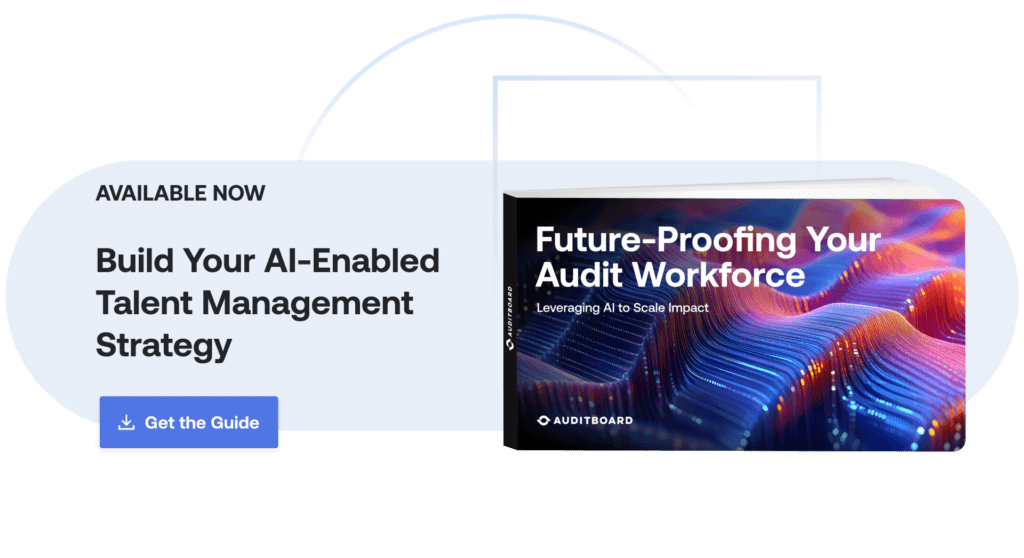
April 5, 2025 • 11 min read
The Ultimate Checklist for Building a Future-Ready Audit Workforce
As new risks emerge in a decade of permacrisis, the work of internal audit teams has never been more important. Yet juggling growing workloads with limited resources has led to burnout and high turnover for internal auditors. It’s no surprise that 52% of CAEs ranked talent management — including diversity, hiring, and retention — a top five risk for 2025.
The good news is that with the right approach, CAEs can better attract and retain talent. Prioritizing human sustainability and leveraging AI responsibly can make all the difference. But how exactly can you implement a strong talent management strategy that keeps internal auditors around?
Below, we’ve included a step-by-step checklist that helps you set your organization’s unique goals, perform skill assessments, evaluate your technology tools and more. Use it as a guide for your own talent management strategy, and download Future-Proofing Your Audit Workforce: Leveraging AI to Scale Impact for more on building a resilient internal audit team.
Checklist: Future-Proofing Your Audit Workforce
“The chief audit executive must strive to ensure that human resources are appropriate, sufficient, and effectively deployed to achieve the approved internal audit plan.””
IIA Standard 10.2
According to The Standards, “appropriate” refers to the mix of knowledge, skills, and abilities; “sufficient” refers to the sufficient quantity of resources; and “effective deployment” refers to assigning resources in a way that optimizes the achievement of the internal audit plan.
Are your internal audit resources appropriate, sufficient, and effectively deployed? Answering this involves a comprehensive understanding of your organization’s audit needs. If your audit scope requires specific knowledge in areas like cybersecurity, ESG, and regulatory compliance, a competency-specific resourcing approach will help ensure your audit team has the necessary skills and knowledge to perform its services.
The following is a checklist for resourcing an efficient, effective, and future-ready audit workforce:
1. Consider different factors when building out your audit team, including
- Organizational characteristics. In particular, the company’s industry, structure, complexity, diversity of cultures/languages, and volatility of its risk environment.
- Pros and cons of hiring full-time employees vs external audit consultants:
If there are staffing shortages, consider bringing in external resources through temp contracts or co-sourcing. - If there are staffing shortages, consider bringing in external resources through temp contracts or co-sourcing.
- Recruiting from diverse backgrounds, experiences, and perspectives. Auditors with diverse backgrounds and experiences will enhance your team’s overall capacity for problem-solving and risk identification.
Tech Tip: AuditBoard’s Skills & Qualifications functionality enables audit teams to create a comprehensive Skills & Qualifications Library, link competencies to individual users, and define the necessary capabilities and credentials for their audit and control tasks. This feature aligns team expertise with audit tasks, optimizes resource allocation, and enhances project efficiency through a comprehensive, standardized, and integrated skills management approach. It also allows audit teams to define what skills and qualifications are needed for their audit projects, ensuring that their resources have the capabilities needed to support the audit plan.
2. Perform a skills assessment to identify areas for improvement — and assign the right resources to projects.
- Identify the core skills needed to support the audit plan and determine assessment methods (certifications, training, experience, etc).
- Evaluate the assigned auditors on a scale against those core competencies (proficient, developing, needs improvement).
- Review the assessment results to identify any skill gaps.
Consider resource pooling, where junior auditors with a core audit get the opportunity to work with practitioners with specialized expertise on various audits, allowing them to gain new specialized skills through experience. - Consider resource pooling, where junior auditors with a core audit get the opportunity to work with practitioners with specialized expertise on various audits, allowing them to gain new specialized skills through experience.
- Based on the assessment results, design tailored training and development programs to address skill gaps.
- Assign auditors to audit projects based on their competencies.
- Revisit the skills assessment periodically (e.g., annually or semi-annually) to track progress and make any necessary updates.
AI-Powered Tip: AuditBoard Intelligent Staffing is an AI-powered resourcing tool that takes users’ skills and qualifications, availability, and work experience into consideration to recommend auditors for assignments — empowering leaders to make the best staffing decisions, track their team members’ experience and progress, and report on that information to relevant stakeholders.
“Having visibility into the skills and qualifications of both our internal team members and external partners will enable us to track trends over time, helping us to make informed decisions about capabilities needed, and ultimately drive more effective strategic planning”
Ram Vijayanathan, Head of Internal Audit, Pinterest
3. Evaluate the appropriateness of the audit schedule and team workload
- More resources are allocated toward high-risk priorities.
Use a risk-based approach to determine where resources are most needed. - Use a risk-based approach to determine where resources are most needed.
- Audits are spaced out throughout the year to avoid peak season burnout.
- Schedule incorporates flexibility to shift resources and accommodate unforeseen events without significantly disrupting the planned audit schedule.
- Audit management systems are leveraged to streamline scheduling, track resource utilization, and ensure deadlines are met.
Tech Tip: AuditBoard’s resource planning capabilitiy aids in budgeting and staffing decisions based on auditors’ availability, reducing the admin burden associated with resource allocation. It gives visibility into the workload of each team member and allows managers to better manage project needs and deadlines
4. Evaluate the effectiveness of your performance measurement metrics, employee incentives, and training/skill development resources.
- Mentorship programs:
If there are no formal mentorship programs, consider implementing a peer-to-peer mentorship program. - If there are no formal mentorship programs, consider implementing a peer-to-peer mentorship program.
- Cross-functional rotational programs that allow auditors to work in different areas of the business.
Ensure auditors maintain objectivity and independence after a rotation as there may be familiarity bias. - Ensure auditors maintain objectivity and independence after a rotation as there may be familiarity bias.
- Mandatory budget for CPE training programs. May include: internal training sessions, online courses, webinars, industry-specific training, soft skills/leadership development programs, and technical training (cybersecurity, AI, ESG, etc.)
- Performance evaluation processes:
Performance metrics are clear, transparent, and easily accessible to employees.
A feedback loop that enhances performance metrics and helps to identify blind spots. - Performance metrics are clear, transparent, and easily accessible to employees.
- A feedback loop that enhances performance metrics and helps to identify blind spots.
- Employee incentives:
Salaries align with industry standards.
Remote/hybrid work flexibility.
Opportunities to work on challenging/high-visibility projects.
Team recognition/awards. - Salaries align with industry standards.
- Remote/hybrid work flexibility.
- Opportunities to work on challenging/high-visibility projects.
- Team recognition/awards.
5. Evaluate the effectiveness of technologies employed by the audit team.
- Purpose-built GRC solutions that enable the team to work more efficiently and effectively.
- Advanced technologies such as AI and analytics to attract talent and enhance auditors’ skill sets.
6. Rely on the work of assurance providers (e.g., risk, compliance, IT governance) to leverage their expertise in specialized areas and optimize time and resources.
- Work performed is well documented, meets standards, and covers the necessary scope.
- Internal audit has access to evidence to support any reliance.
AI-Powered Tip: AuditBoard’s AI-powered connected risk platform empowers organizations to seamlessly consolidate, share, and analyze data across solutions and teams (audit, SOX, IT Compliance/Security, ERM, etc.). This integrated approach fosters collaboration and real-time insights, reduces duplication of effort and audit fatigue, and allows teams to align on risk efforts and make data-driven decisions.
The Future of Internal Audit Is Human, Powered by Responsible AI
People are always the most important element of a strong internal audit team. AI isn’t here to replace the work of exceptional internal auditors. In fact, when it’s used correctly, AI helps internal auditors manage resources more effectively, focus on higher-value work, and avoid burnout.
Investing in skills training, career development and enabling technologies will unlock new opportunities for your internal audit team and empower them to better address evolving risks.
Get more insights on the future of internal audit, talent management and the new IIA Standard 10.2 by downloading the complete ebook, Future-Proofing Your Audit Workforce: Leveraging AI to Scale Impact.
You may also like to read


Audit automation in 2025: How to improve efficiency and assurance

Strategic audit planning in 2025: A guide for GRC leaders

Top security audit software — cut fatigue & streamline workflows

Audit automation in 2025: How to improve efficiency and assurance

Strategic audit planning in 2025: A guide for GRC leaders
Discover why industry leaders choose AuditBoard
SCHEDULE A DEMO




